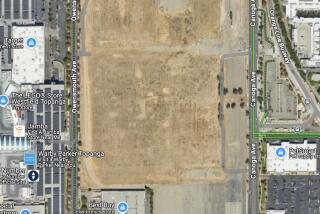Pollution Detected at Unocal Oil Field : Environment: Officials don’t know how much ground water is tainted with petroleum thinner. Firm says it is cooperating with cleanup efforts.
- Share via
SAN FRANCISCO — The Unocal oil field at Guadalupe, which has long been a source of beach contamination, has also leaked petroleum thinner into the ground water beneath the facility, state regulators and company officials said Tuesday.
Although officials are uncertain of the extent of the contamination at the oil field west of Santa Maria, one test well found a five-foot thick layer of the clear, diesel-like liquid floating on the ground water.
Unocal already faces the possibility of criminal charges for not properly reporting spills of the petroleum thinner, known as diluent, onto the beach and into the ocean over the last 15 years.
Earlier this month, state and local authorities armed with a search warrant seized 68 boxes of documents from Unocal offices. They hope the records will show that company officials knew of the leaks and will help establish how much of the fluid has contaminated the beach, ocean and ground water.
Company officials deny any improper action and say they are cooperating with authorities to determine the extent of the problem and to clean up the contamination.
“We know over the life span of the field there have been leaks,” said Janet McClintock, a Unocal spokeswoman. “We know that there are four areas of potential contamination.”
Diluent has long been pumped into wells at the Guadalupe field to thin the heavy crude oil and make it easier to pump out of the ground. But breaks in the network of underground pipes have allowed vast quantities of the fluid to leak into the ground.
Some of the fluid traveled underground to the beach and into the ocean. The diluent also reached the ground water under the oil field, nearly a mile from the beach in some places.
Since Unocal built an underground wall at the beach in 1990 and began pumping the diluent out of the ground, it has recovered 651,000 gallons. No one knows how much of the fluid escaped into the ocean since the first leaks were found in 1978.
By comparison, the Huntington Beach oil spill in 1990 totaled 399,000 gallons of crude oil.
At the behest of the Central Coast Regional Water Quality Control Board, the company began testing ground water inland from the beach in April to determine if there were any diluent spills in that part of the oil field. Of 14 test wells, four contained diluent, but Unocal has not yet determined the extent of the contamination.
“The company has done some investigative work and found some additional spills,” said Bill Leonard, executive director of the regional board. “Now they are convinced they need to look at the whole field. They are trying to find the edges of the plume.”
The June 11 search of Unocal offices by state Fish and Game wardens, regional water board investigators and San Luis Obispo County authorities came nearly a year after the Department of Fish and Game searched Unocal’s offices and carted off 24 boxes of possible evidence.
Investigators had hoped the records would show how much diluent was pumped into the system and how much was later extracted, indicating how much leaked into the ocean or ground water. But one official said Unocal’s record-keeping may not have been efficient enough to show how much diluent disappeared.
San Luis Obispo County Dist. Atty. Barry La Barbera, who is considering whether to bring charges against the firm for not properly reporting spills, had no comment Tuesday on the progress of the case.
More to Read
Sign up for Essential California
The most important California stories and recommendations in your inbox every morning.
You may occasionally receive promotional content from the Los Angeles Times.









